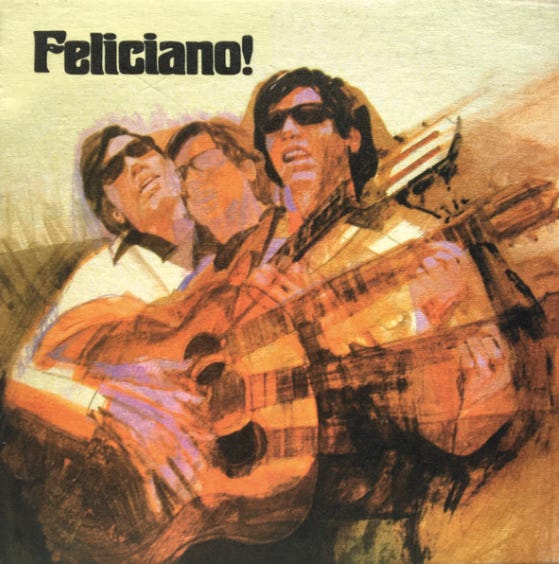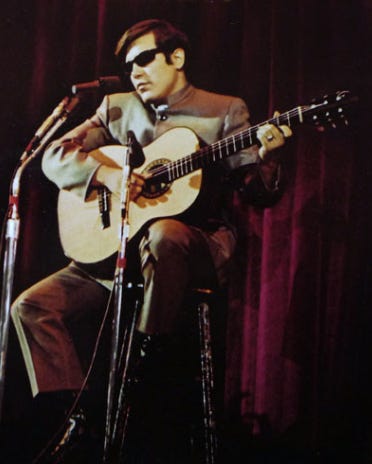Today, on the eve of July 4th, I’m revisiting an interview that I did with crossover pioneer José Feliciano about his historic and then-controversial 1968 performance of “The Star Spangled Banner” at the World Series.
I interviewed the affable and outspoken José, that time, in 2018, on a day that can now seems long ago, in a country that can now seems far away, when he again sang the national anthem. On that occasion it was for an audience of 20 new U.S. citizens, comprising immigrants from 17 countries, at a naturalization ceremony that took place at the Smithsonian’s National Museum of American History. At the ceremony, Feliciano gifted his bespoke Concerto Candelas guitar, that he played during the recording of his breakout hit “Light My Fire,” to the Smithsonian. It had been 50 years since the release of his Grammy-winning cover of the song by The Doors, which took him to No. 3 on Billboard’s Hot 100 chart. The track appeared on Feliciano!, the enduring album of Latin-tinged covers which peaked at No. 2 on the Billboard 200 albums chart upon its release.
That success resulted in an invitation for the Puerto-Rican singer-songwriter to perform “The Star-Spangled Banner” during game five of the 1968 World Series at Detroit’s Tiger Stadium.
Feliciano, who was 23-years-old, sat on a stool coffee house-style at the side of the field, and performed on the guitar he then donated to the Smithsonian. The blind musician wore dark glasses and was accompanied by his guide dog.
His personal take on “The Star-Spangled Banner” evoked the singer’s involvement in New York City’s folk scene. It also ignited a controversy that reflected the tense atmosphere in the United States in the era of the Vietnam War and the Civil Rights movement.
Boos could be heard in the audience, and many television viewers called in to NBC, which was airing the game, to complain about Feliciano’s “hippie” version of “The Star-Spangled Banner.”
“Some people wanted to report him because he’s from Puerto Rico and he had dark glasses and long hair,” the artist’s wife Susan Feliciano later told me. “They were not paying attention to the fact that he also had a guide dog.”
During our interview, José Feliciano recalled how radio stations stopped playing his songs after the performance.
“Now everybody has been doing the national anthem in their own style, but in 1968 I was the one that took the heat,” he said, “It cut my career for quite a while.”
He also recalled some anti-Latino sentiment in the mix of complaints about the performance. “People will say it was a flamenco version. But it was not. It was a gospel, soulful version.”
Feliciano’s label, RCA, countered the complaints about his World Series performance by quickly releasing Feliciano’s version of the song as a single. The track was picked up by rock stations and even reached No. 50 on the Hot 100 chart.
But still, Feliciano referred to the World Series episode as a “disaster and nightmare.”
It also had an impact on Feliciano’s recording of a Christmas song. He said that when he wrote “Feliz Navidad,” which was released in 1970, he felt that a Christmas song with Spanish lyrics could also alienate American radio programmers. So he made the song bilingual.
“If I had left it Spanish only, then I knew the English stations might not play it,” Feliciano told me in a previous interview. “So I decided to write an English lyric, ‘I want to wish you a merry Christmas.’ And then there was no way the stations could lock that song out of the programming.”
While Feliciano spoke English at school, he grew up in a Spanish-speaking home. “My parents did not want us to lose our culture and our language,” he recalled. “And that was a good thing.”
Feliciano, who was born in Lares, Puerto Rico, moved to New York’s Spanish Harlem with his family when he was five years old. “I went through the immigration thing,” he said. “But when I got to New York it wasn’t so tough for me. I went to school. I went to P.S. 57, then I went to the Lighthouse for the Blind on 59th St. “I guess being blind is a great leveler,” he quipped.
While Feliciano spoke English at school, he grew up in a Spanish-speaking home. “My parents did not want us to lose our culture and our language,” he recalled. “And that was a good thing.”
“I guess being blind is a great leveler,” he quipped.
Feliciano’s Smithsonian performance took place in the museum’s Flag Hall, where a copy of the national anthem hand written by its composer Francis Scott Key was on display.
“I could be a sarcastic bastard and say it’s too little too late,” Feliciano told me, referring to the initial reaction to his “Star-Spangled Banner.” But he said he was grateful to the Smithsonian for the acknowledgement, calling it “a beautiful thing.”
In 2019, Feliciano release his own national anthem of sorts, “I’m America.” The video for the song makes reference to his 1968 World Series performance.
…I'm the freedom in the song we're singing
I'm the seed that's in the dust
I'm the prayer in god we trust
A place to dream for all of us
I'm America, oh yes I am
I'm the fathers, I'm the sons
I'm the footprints in the mud
I'm a shelter washed in blood
Don't you know I'm America?
I came here with nothing
That's all I know
I'm the seed that's in the dust
I'm the prayer in god we trust
A place to dream for all of us
I'm America
I'm America
I'm America
I'm America...
I'm America
I'm proud to be a Puertorican American
I'm an American
From “I’m America” by José Felicano
A version of this story appeared in Billboard Magazine.







What did he mean, "I went through the immigration thing?"
What immigration thing is he referring to as an Act of Congress gave P.R.'s, who never asked for it, American Citizenship in 1917! Just in time me for WWI.
Also, as I recall, there were calls in the press for his "deportation" alongside the most blatantly racists of comments!